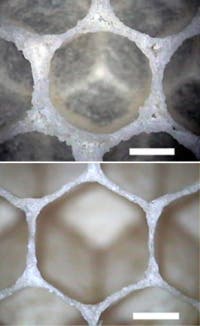Honeybees are exquisite and majestic beings, which have always caught the imagination of people. Bees are typically associated with feminine energy, because they are ruled by queens, particularly with the roman goddess Venus. In some cultures, bees also represent wisdom. From a biological point of view however, bees could be definitely associated with motherhood. Without bees, a myriad of plants would die out due to lack of pollination. It’s clear that honeybees are of the utmost importance for the biosphere’s delicate balance.
There’s one more thing honeybees are cherished and appreciated by humans for: their display of biological engineering, namely for producing hexagon honeycombs. This may be the only thing people overly credit bees for, though. The perfect hexagonal honeycombs which have awed and inspired people for thousands of years may primarily result from the physics of surface tension, the honeybees themselves being responsible only for laying the foundations.
The findings come after researchers at University of Cardiff, UK, led by engineer Bhushan Karihaloo, closely studied a colony of bees. After they flushed the colony out by smoking the hive, the researchers examined the honeycomb structures, some in their last stage of development, while other in their first incipient form. The scientists found that bees first produce cells that are circular in cross section, which eventually build up like a layer of bubbles. The wax, heated by the bees’ bodies, then gets pulled into hexagonal cells by surface tension at the junctions where three walls meet. Both experiments and models have confirmed these findings.

Why hexagon of all shapes? Well, a geometric array of identical cells with simple polygonal cross sections can take only one of three forms: triangular, square or hexagonal. Of these, in this particular situation, the hexagon shape takes the least amount of wall area, thus using less wax. Nature , as always, is guided by efficiency.
But wax is solid, right? Yes, and for the wax to flow, this is why the bees heat up the cells – to be more precise, to 45 oC or warm enough to flow like a viscous liquid. Not all bees heat up the wax, of course, otherwise the whole colony would collapse. A median ambient temperature of 25 degrees in the hive supports this idea. As an interesting fact, one of the greatest foreseeing minds, Charles Darwin, also had the idea that the bees might first make circular cells, which become hexagonal subsequently, but lacked evidence to support his proposal.
Still with knowing this, bees still can be seen as excellent engineers of the animal kingdom. For one, it’s they who lay out the ground work, and make sure physics takes its course by heating the wax. They also use their head as a plumb-line to measure the vertical, tilt the axis of the cells very slightly up from the horizontal to prevent the honey from flowing out, and measure cell wall thicknesses with extreme precision. Really, bees are so amazing!
The study was reported in the Journal of the Royal Society Interface.
Was this helpful?



